Get in touch with us today!
If you have any questions, enquiries or just want to say how much you like us (or what we can do better), please drop us a line.
Over lockdown, we have been running webinars more frequently in order to help provide more opportunities for self-development. We are have been delighted by the overwhelming popularity and success of these webinars, with increasingly high numbers in attendance. We actively encourage participation, through the medium of polls as well as annotating slides via Zoom. As a result, we have acquired some interesting data identifying various workforce concerns and lockdown challenges. In this blog, we will explore this data, identifying lockdown challenges, and how we can overcome them.
In our most recent webinar on the 30th July, ‘Practical Wellbeing Strategies for Line Managers’, we had over 191 attendees. During this session, we had a number of polls, three of which were taken over the course of the webinar, and the final five were taken as a parting survey of sorts. Certainly, wellbeing is an important topic, which is why we have had 3 webinars on this topic, including our most recent session. In light of this, the first three poll questions we can compare over time.
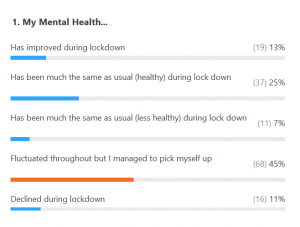
Mental health and wellbeing has been a key concern of many businesses over lockdown, and rightly so. Our very first poll looks at personal mental health, of which the majority (45% out of 151 voters) showed that mental health has fluctuated throughout lockdown. Another 32% stated their mental health had roughly stayed the same as usual, 11% said their mental health had declined whereas the final 13% said their mental health had improved.
Certainly, these are particularly interesting results when compared to the same poll taken on a webinar at the beginning of June 2020. In June, the results were similar in that the majority felt that their mental health had fluctuated (56% of around 90 voters). However, no one said their mental health had improved in June. Perhaps this is an indication that the lifting of lockdown restrictions has already had an impact on mental health. Alternatively, it could be the influence of the summer season increasing our moods. This can be a cause for concern if another lockdown were to occur in winter, where seasonal affective disorder can really take over.
It is clear that lockdown has affected mental health, and is still a challenge for some. Therefore, it is more important than ever to be empathetic with our employees. We have a variety of resources on mental health and wellbeing. One of which is our free infographic ‘10 tips for Managers to Encourage Wellbeing‘. We also have podcasts surrounding this topic, which you can access here.
See below for the graph displaying the mental health changes over time.
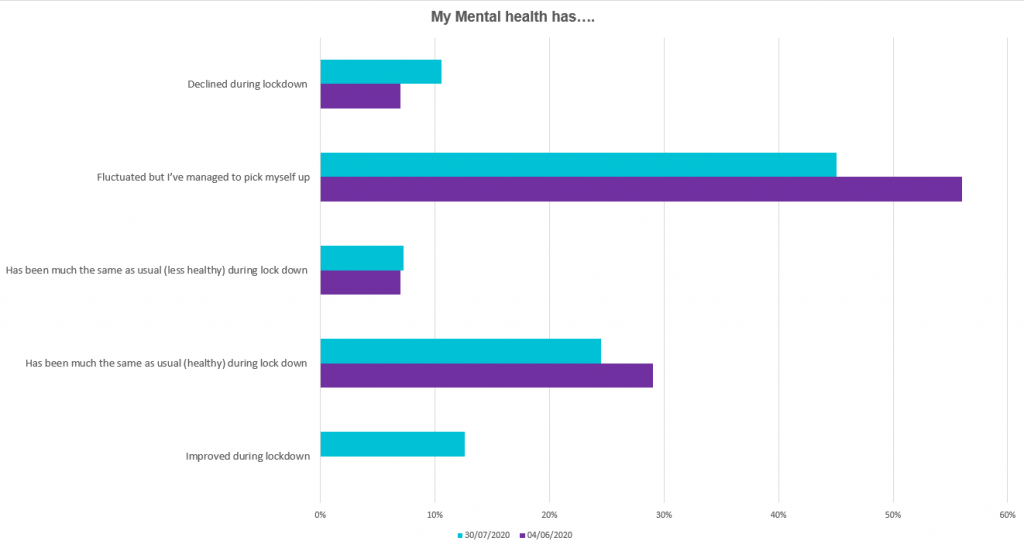

Our second poll in our most recent webinar, ‘Practical Wellbeing Strategies for Line Managers’, looked at workforce concerns. As this question was multiple choice, we did ask attendees to pick their top three concerns. The highest concern for most was the safety of the workplace (54% out of 153 voters). This is unsurprising given COVID-19 is still very much at the forefront of most people’s minds, especially with those moving back into the office.
In addition, the second-highest concern was the ability to continue working remotely (49%), followed by job security (46%). The ability to continue working remotely is most likely linked to the safety of the workplace. With people wondering and worrying if the time is right to return? It is important to have a dialogue with employees around this, with considerations to their own personal circumstances. The third highest concern, job security, is likely a reflection of the impact the Coronavirus has had on our economy. Certainly, some businesses have struggled to survive through the lockdown. Thereby leaving some to wonder if their job is next, particularly for sectors worst hit such as Hospitality and Tourism.
Interestingly, when we look at workforce concerns over time, using our results from previous webinars (dated 4th June, 9th July and 30th July), we can see that the highest concern is always the safety of the workplace. However, both childcare and getting back into work (if furloughed) have reduced significantly since June. With childcare concerns decreasing by 14% and getting back to work decreasing by 23% by the end of July. This reflects the ending of furlough schemes for some organisations, with employees already back at work. The decrease in childcare concerns is likely a reflection of some organisations providing the ability to continue working remotely based on individual circumstances.
See below for the graph displaying the changes in concerns over time. It is worth noting that the category of ‘ability to continue working remotely’ didn’t exist in June. Instead, this category was subsequently added for the two webinars in July.

So, what can we do to ease these concerns? The root cause of these main concerns is uncertainty. Therefore, clear communication is key. Communicate safety plans for the office if it is reopening, or communicate that you plan to continue to work remotely for the foreseeable future. Certainly, if there are plans to reopen the office, you should open dialogue with your staff around if they have any concerns. Perhaps they have personal circumstances that require them to continue working remotely. In addition, communication can also help with concerns about job security. Be open on your plans to revitalise the business, and ask them to be a part of this. This can be a great way of having a positive outlook and encouraging the best out of our staff. Perhaps, you may need to change their role for a short period of time to best support the business.
It is clear that empathy and communication are key to tackling the challenges posed by these first two polls. Furthermore, workforce concerns and staff wellbeing are undoubtedly linked. If we can ease our people’s anxiety, this can only be beneficial for their mental health.
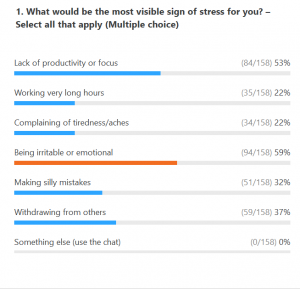
Our third question looks at what visible signs of stress people display, in the hopes of highlighting how we can then recognise this in others. Again, as this question was multiple choice, we did ask attendees to pick their top three. Of those polled, the highest visible sign of stress is being irritable or emotional (59% of 158 votes), followed by lack of productivity or focus (53%), withdrawing from others (37%), making silly mistakes (32%), complaining of tiredness/aches (22%) and working very long hours (22%).
When we compare this to our previous webinars, we can see that being irritable or emotional is the sign of stress most easily recognised. However, the percentage for this category has decreased by 12% since June. Furthermore, we can see the lack of productivity or focus has increased by 11% from June to July. This highlights the need to ensure your employees have the right goals, and to review these frequently. It is worth noting that the category of ‘complaining of tiredness/aches’ didn’t exist in June. Instead, this category was subsequently added for the two webinars in July. See below for the graph displaying the changes in visible signs of stress over time.
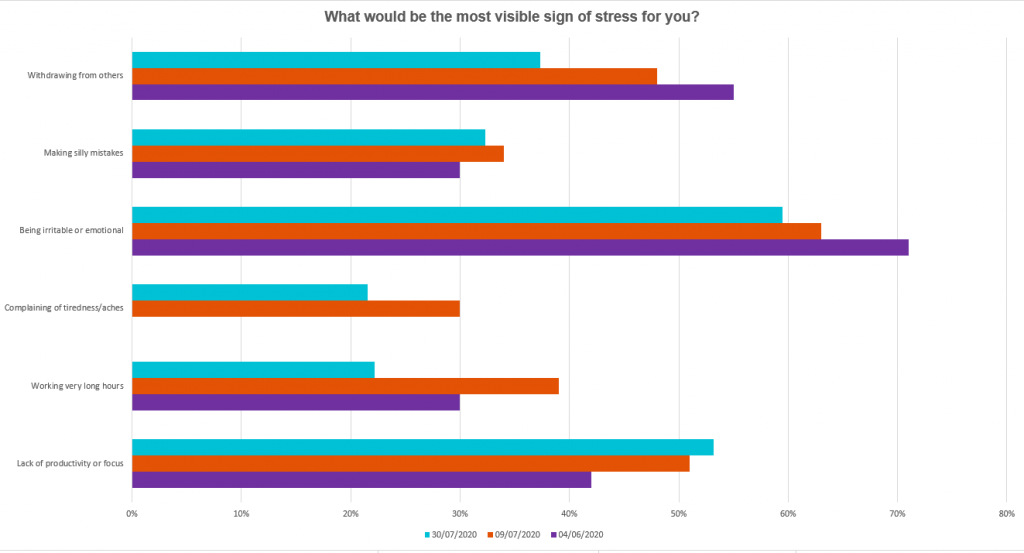
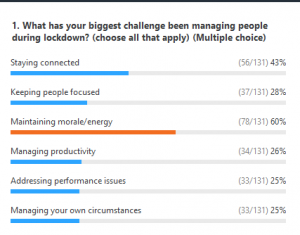
Towards the end of the webinar, we had a series of 5 questions based on the impact that Covid-19 had. 131 of our 191 attendees took part. Of those polled, 60% said the biggest people management challenge they had faced over lockdown was maintaining morale/energy. This comes as no surprise to us, as we had a Linkedin poll back in July 2020 which showed that around nine-in-ten UK workers were suffering from some level of ‘lockdown lethargy’. The second-highest challenge noted was the issue of staying connected, perhaps reflecting the issues of remote working and possible concerns of isolation. The other categories had similar levels of votes between 25%-28%. These categories included: keeping people focused, managing productivity, addressing performance issues and managing your own circumstances.
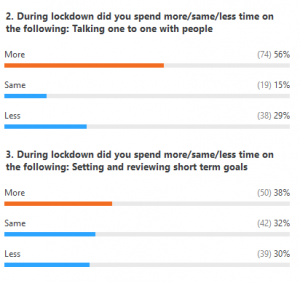 The second, third, and fourth questions in this poll series focused on whether people management activities had changed over the lockdown period. The second question concerned whether the frequency of 1-2-1’s had changed, from which the majority (56% of 131 voters) stated they had spent more time on 1-2-1’s, possibly in an attempt to stay connected and ensure their team was on track. Another 29% stated they had less 1-2-1’s and the last 15% stated the frequency had stayed the same.
The second, third, and fourth questions in this poll series focused on whether people management activities had changed over the lockdown period. The second question concerned whether the frequency of 1-2-1’s had changed, from which the majority (56% of 131 voters) stated they had spent more time on 1-2-1’s, possibly in an attempt to stay connected and ensure their team was on track. Another 29% stated they had less 1-2-1’s and the last 15% stated the frequency had stayed the same.
The next question concerned the amount of time spent setting and reviewing short-term goals, which again the majority (38% of 131 voters) stated they had spent more time on this activity. The rest of those polled voted 32% had spent the same amount of time reviewing goals, and the last 30% had spent less time. Certainly, we would recommend spending more time on both of these activities in terms of best practices when it comes to managing a remote working team. Therefore, it is definitely encouraging to see the majority of companies seem to be taking this approach.

In addition, the fourth question in this series looks at the time spent on managing performance issues, as we knew that this was a concern for some. In this case, the majority of those polled (44%) stated they spent the same amount of time dealing with this. Some have had concerns that remote working may increase performance issues, and reduce productivity, but this poll result reflects that this is not necessarily the case.
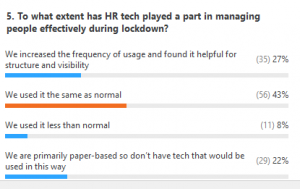 Our final poll question concerned whether HR technology had helped management practices over the lockdown period. Surprisingly, over one-fifth of those polled are primarily paper-based so they were unable to utilise HR technology to help with the increased people management activities as identified in the previous questions. As the other 78% did have HR technology, most used it the same as normal (43%), then some increased the frequency of usage (27%), with the minority using it less than normal (8%).
Our final poll question concerned whether HR technology had helped management practices over the lockdown period. Surprisingly, over one-fifth of those polled are primarily paper-based so they were unable to utilise HR technology to help with the increased people management activities as identified in the previous questions. As the other 78% did have HR technology, most used it the same as normal (43%), then some increased the frequency of usage (27%), with the minority using it less than normal (8%).
Certainly, we would expect the usage of HR technology to perform people management to have increased, which is why we were surprised the majority used it the same as normal. The HR technology should help make increased activities of setting and reviewing short term goals and 1-2-1’s easier, with a quick backlog to refer to. If this is done via paper methods, these can easily be lost or misplaced.
Now that we have identified the lockdown challenges we are facing and how these are changing over time, the question is how can we best overcome them? The key is to put processes in place to mitigate any main concerns or challenges. For example, we identified that people may be suffering from a lack of productivity or focus due to stress. There are two ways to then mitigate this, one is to ensure they have relevant short-term goals and to review these regularly in 1-2-1’s. These 1-2-1’s can then also be used as a way to communicate and understand your employee’s mental health and wellbeing. You can discuss ways of reducing stress, including recommending self-care activities and encouraging work breaks. We have an HR Uprising podcast that looks more into practical wellbeing strategies here.
It is important to remember Rome wasn’t built in a day, and to take time to consider any lockdown challenges you are facing. Having an open dialogue with your staff will also help you to have a better understanding of concerns they may be facing, and to openly communicate on plans such as returning to work, even if the plan is to not do so for a while. Coronavirus has created a lot of uncertainty, which undoubtedly creates extra stress for many, affecting their work output. As conscientious employers and managers, we should do our best to provide clarity not just what is expected from them, but what is expected from the organisation.
Part of our ethos is to help build a better workplace for people. We achieve this through great performance management software, the HR Uprising Podcast, and a variety of free thought leadership resources. Therefore, if you would like to learn more about this topic, you can find some additional resources using the buttons below.
We also have a team of organisational development consultants who are on-hand to help meet your needs for culture change. If you would like to find out more about this service, why not get in touch by contacting us here.
Infographic: 10 Tips for Managers to Encourage Wellbeing
Infographic: 5 Steps to Boost Employee Energy
The HR Uprising Podcast: Practical Wellbeing Strategies
Please complete the details to receive a 3 minute system tour direct to your inbox!
If you are looking for performance management software for 1000+ employees get in touch for a quote today.
Talk to one of our partnership specialists today.
Fill in your details below and then please check your email for a link to the 3 minute overview of Actus Software
If you have any questions, enquiries or just want to say how much you like us (or what we can do better), please drop us a line.